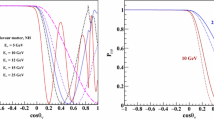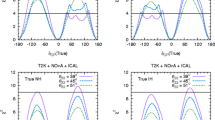Abstract
We explore the prospects of determining the octant of θ 23 with atmospheric neutrinos at PINGU. We study in detail the impact of energy and angle resolutions of the neutrino on the octant sensitivity. We show that the systematic uncertainties on the atmospheric neutrino flux predictions, especially the ones which affect the energy and zenith angle spectrum of the neutrinos, make a rather drastic reduction of the sensitivity of PINGU. We also study the prospects of measuring the octant of θ 23 in the long baseline experiments T2K and NOνA in conjunction with the reactor experiments. We study this for two configurations of NOνA and T2K and make a comparative analysis of them. With just 3 years of statistics, PINGU would have an octant sensitivity of more than 3σ C.L. for sin2 θ 23 < 0.419 and sin2 θ 23 > 0.586 if we add the reactor data and if normal hierarchy is true. On addition of the data from T2K and NOνA, the sensitivity improves so that we have an octant sensitivity at the 4σ C.L. for sin2 θ 23 < 0.426 and sin2 θ 23 > 0.586 if normal hierarchy is true. Even a 5σ significance for the right octant can be expected if sin2 θ 23(true) < 0.413 for the true normal hierarchy. The sensitivity for the true inverted hierarchy is lower and we expect a 3σ sensitivity of the octant of θ 23 for sin2 θ 23(true) < 0.43 and > 0.585 from the combined data set for this case.
Similar content being viewed by others
References
D.J. Koskinen, IceCube-DeepCore-PINGU: Fundamental neutrino and dark matter physics at the South Pole, Mod. Phys. Lett. A 26 (2011) 2899 [INSPIRE].
For details of the IceCube experiment see icecube.wisc.edu.
IceCube collaboration, M. Aartsen et al., Measurement of Atmospheric Neutrino Oscillations with IceCube, Phys. Rev. Lett. 111 (2013) 081801 [arXiv:1305.3909] [INSPIRE].
IceCube and PINGU collaborations, M. Aartsen et al., PINGU Sensitivity to the Neutrino Mass Hierarchy, arXiv:1306.5846 [INSPIRE].
E.K. Akhmedov, S. Razzaque and A.Y. Smirnov, Mass hierarchy, 2-3 mixing and CP-phase with Huge Atmospheric Neutrino Detectors, JHEP 02 (2013) 082 [Erratum ibid. 1307 (2013) 026] [arXiv:1205.7071] [INSPIRE].
M. Ribordy and A.Y. Smirnov, Improving the neutrino mass hierarchy identification with inelasticity measurement in PINGU and ORCA, Phys. Rev. D 87 (2013) 113007 [arXiv:1303.0758] [INSPIRE].
S.K. Agarwalla, T. Li, O. Mena and S. Palomares-Ruiz, Exploring the Earth matter effect with atmospheric neutrinos in ice, arXiv:1212.2238 [INSPIRE].
W. Winter, Neutrino mass hierarchy determination with IceCube-PINGU, Phys. Rev. D 88 (2013) 013013 [arXiv:1305.5539] [INSPIRE].
M. Blennow and T. Schwetz, Determination of the neutrino mass ordering by combining PINGU and Daya Bay II, JHEP 09 (2013) 089 [arXiv:1306.3988] [INSPIRE].
S.-F. Ge, K. Hagiwara and C. Rott, Physics of Atmospheric Neutrino Oscillations with a Huge Underground Detector, arXiv:1309.3176 [INSPIRE].
H. Minakata, H. Sugiyama, O. Yasuda, K. Inoue and F. Suekane, Reactor measurement of θ 13 and its complementarity to long baseline experiments, Phys. Rev. D 68 (2003) 033017 [Erratum ibid. D 70 (2004) 059901] [hep-ph/0211111] [INSPIRE].
K. Hiraide et al., Resolving θ 23 degeneracy by accelerator and reactor neutrino oscillation experiments, Phys. Rev. D 73 (2006) 093008 [hep-ph/0601258] [INSPIRE].
K.B.M. Mahn and M.H. Shaevitz, Comparisons and combinations of reactor and long-baseline neutrino oscillation measurements, Int. J. Mod. Phys. A 21 (2006) 3825 [hep-ex/0409028] [INSPIRE].
P. Huber, M. Lindner, T. Schwetz and W. Winter, First hint for CP-violation in neutrino oscillations from upcoming superbeam and reactor experiments, JHEP 11 (2009) 044 [arXiv:0907.1896] [INSPIRE].
S.K. Agarwalla, S. Prakash and S.U. Sankar, Resolving the octant of θ 23 with T2K and NOvA, JHEP 07 (2013) 131 [arXiv:1301.2574] [INSPIRE].
A. Chatterjee, P. Ghoshal, S. Goswami and S.K. Raut, Octant sensitivity for large θ 13 in atmospheric and long baseline neutrino experiments, JHEP 06 (2013) 010 [arXiv:1302.1370] [INSPIRE].
M. Gonzalez-Garcia, M. Maltoni and A.Y. Smirnov, Measuring the deviation of the 2-3 lepton mixing from maximal with atmospheric neutrinos, Phys. Rev. D 70 (2004) 093005 [hep-ph/0408170] [INSPIRE].
S. Choubey and P. Roy, Probing the deviation from maximal mixing of atmospheric neutrinos, Phys. Rev. D 73 (2006) 013006 [hep-ph/0509197] [INSPIRE].
D. Indumathi, M. Murthy, G. Rajasekaran and N. Sinha, Neutrino oscillation probabilities: sensitivity to parameters, Phys. Rev. D 74 (2006) 053004 [hep-ph/0603264] [INSPIRE].
A. Samanta and A.Y. Smirnov, The 2-3 mixing and mass split: atmospheric neutrinos and magnetized spectrometers, JHEP 07 (2011) 048 [arXiv:1012.0360] [INSPIRE].
K. Abe et al., Letter of Intent: The Hyper-Kamiokande Experiment — Detector Design and Physics Potential —, arXiv:1109.3262 [INSPIRE].
V. Barger et al., Neutrino mass hierarchy and octant determination with atmospheric neutrinos, Phys. Rev. Lett. 109 (2012) 091801 [arXiv:1203.6012] [INSPIRE].
A. Blake and H. Gallaghar, Potential for Atmospheric Neutrinos in LAr Detectors, talk at International Symposium on Opportunities in Underground Physics for Snowmass (ISOUP), Asilomar U.S.A. (2013).
Km3Net collaboration, P. Coyle et al., ORCA: Oscillation Research with Cosmics in the Abyss, contribution to the European Strategy Preparatory Group Symposium, Krakow Poland (2012).
T2K collaboration, Y. Itow et al., The JHF-Kamioka neutrino project, hep-ex/0106019 [INSPIRE].
P. Machado, H. Minakata, H. Nunokawa and R.Z. Funchal, What can we learn about the lepton CP phase in the next 10 years?, arXiv:1307.3248 [INSPIRE].
R. Patterson, Status of NOvA, talk at Neutrino 2012 Conference, Kyoto Japan (2012), http://neu2012.kek.jp.
DAYA-BAY collaboration, F. An et al., Observation of electron-antineutrino disappearance at Daya Bay, Phys. Rev. Lett. 108 (2012) 171803 [arXiv:1203.1669] [INSPIRE].
RENO collaboration, J. Ahn et al., Observation of Reactor Electron Antineutrino Disappearance in the RENO Experiment, Phys. Rev. Lett. 108 (2012) 191802 [arXiv:1204.0626] [INSPIRE].
DOUBLE-CHOOZ collaboration, Y. Abe et al., Indication for the disappearance of reactor electron antineutrinos in the Double CHOOZ experiment, Phys. Rev. Lett. 108 (2012) 131801 [arXiv:1112.6353] [INSPIRE].
T2K collaboration, K. Abe et al., Indication of Electron Neutrino Appearance from an Accelerator-produced Off-axis Muon Neutrino Beam, Phys. Rev. Lett. 107 (2011) 041801 [arXiv:1106.2822] [INSPIRE].
MINOS collaboration, P. Adamson et al., Improved search for muon-neutrino to electron-neutrino oscillations in MINOS, Phys. Rev. Lett. 107 (2011) 181802 [arXiv:1108.0015] [INSPIRE].
S.K. Agarwalla, S. Prakash, S.K. Raut and S.U. Sankar, Potential of optimized NOvA for large θ 13 & combined performance with a LArTPC & T2K, JHEP 12 (2012) 075 [arXiv:1208.3644] [INSPIRE].
NOvA collaboration, D. Ayres et al., NOvA: Proposal to build a 30 kiloton off-axis detector to study ν(μ) → ν(e) oscillations in the NuMI beamline, hep-ex/0503053 [INSPIRE].
Daya-Bay collaboration, X. Guo et al., A Precision measurement of the neutrino mixing angle θ 13 using reactor antineutrinos at Daya-Bay, hep-ex/0701029 [INSPIRE].
RENO collaboration, J. Ahn et al., RENO: An Experiment for Neutrino Oscillation Parameter θ 13 Using Reactor Neutrinos at Yonggwang, arXiv:1003.1391 [INSPIRE].
F. Ardellier et al., Letter of intent for Double-CHOOZ: A Search for the mixing angle θ 13, hep-ex/0405032 [INSPIRE].
M. Honda, T. Kajita, K. Kasahara and S. Midorikawa, A new calculation of the atmospheric neutrino flux in a 3-dimensional scheme, Phys. Rev. D 70 (2004) 043008 [astro-ph/0404457] [INSPIRE].
D. Cowan, PINGU, talk at Snowmass Cosmic Frontier Workshop, SLAC, Menlo Park U.S.A. (2013).
A.M. Dziewonski and D. L. Anderson, Preliminary Reference Earth Model, Phys. Earth Planet. Inter. 25 (1981) 297.
H. Nunokawa, S.J. Parke and R. Zukanovich Funchal, Another possible way to determine the neutrino mass hierarchy, Phys. Rev. D 72 (2005) 013009 [hep-ph/0503283] [INSPIRE].
P. Huber, J. Kopp, M. Lindner, M. Rolinec and W. Winter, New features in the simulation of neutrino oscillation experiments with GLoBES 3.0: General Long Baseline Experiment Simulator, Comput. Phys. Commun. 177 (2007) 432 [hep-ph/0701187] [INSPIRE].
P. Huber, M. Lindner and W. Winter, Simulation of long-baseline neutrino oscillation experiments with GLoBES (General Long Baseline Experiment Simulator), Comput. Phys. Commun. 167 (2005) 195 [hep-ph/0407333] [INSPIRE].
A. Ghosh, T. Thakore and S. Choubey, Determining the Neutrino Mass Hierarchy with INO, T2K, NOvA and Reactor Experiments, JHEP 04 (2013) 009 [arXiv:1212.1305] [INSPIRE].
A. Ghosh and S. Choubey, Measuring the Mass Hierarchy with Muon and Hadron Events in Atmospheric Neutrino Experiments, JHEP 10 (2013) 174 [arXiv:1306.1423] [INSPIRE].
A. Ghosh and S. Choubey, in preparation.
Author information
Authors and Affiliations
Corresponding author
Additional information
ArXiv ePrint: 1309.5760
Rights and permissions
About this article
Cite this article
Choubey, S., Ghosh, A. Determining the octant of θ 23 with PINGU, T2K, NOνA and reactor data. J. High Energ. Phys. 2013, 166 (2013). https://doi.org/10.1007/JHEP11(2013)166
Received:
Revised:
Accepted:
Published:
DOI: https://doi.org/10.1007/JHEP11(2013)166




